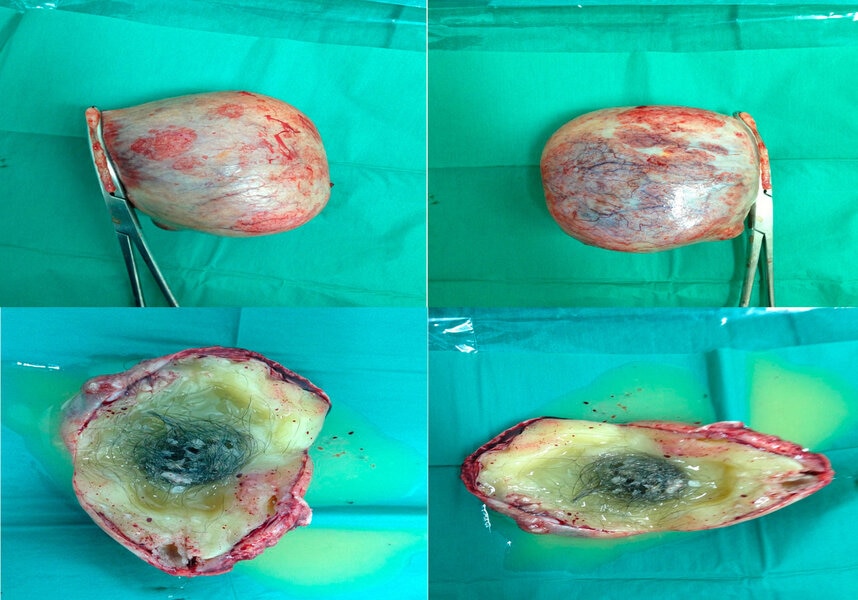Create a free profile to get unlimited access to exclusive videos, sweepstakes, and more!
The Terrifying, Real-Life Science Behind Gruesome Horror Movie Malignant
Could that... really happen?

**Warning: There are spoilers for Malignant below.**
James Wan’s Malignant (streaming now on Peacock) is the horror movie of the moment. It flips back and forth between being sort of campy and being innovative. Where it falls short seems mostly intentional, and it’s at least a departure of sorts from the kinds of things Wan is known for (The Conjuring, Insidious). It’s the reveal in the third act that makes the movie worth discussing, at least within the lines of this column.
We see the events of the film through the eyes (sometimes literally) of its protagonist, Madison. After what must be a contender for the worst day ever set to film — spousal abuse, a murder, a home invasion, and a miscarriage, Maddie finds herself mysteriously connected to a monster on a killing spree who may or may not be her childhood imaginary friend, Gabriel.
In the final act, it’s revealed that Gabriel is real, and is attached to the back of Maddie's head, the diminished remains of a teratoma which was mostly surgically removed when she was young. The two of them share a body, their minds connected, and sometimes Gabriel takes over. It’s good fodder for horror, but could it happen?
TERATOMAS
Teratomas, from the Greek word teratos, meaning monster, are a type of tumor that differ from more common tumors in one specific way: their ability to develop multiple and sometimes complex tissue types. In most instances, a tumor is made of a proliferation of one type of tissue. When dissected, we don’t find any complex structures, just cell division gone mad.
Teratomas, instead, can contain complex tissues including hair, teeth, muscle, and even brain tissue. In fact, about one in five ovarian tumors contain complex tissues. Teratomas are so common in ovaries because of one of the ways they can form. It’s believed they may result from pluripotent germ cells dividing and differentiating in a way that is contrary to their usual function. In short, eggs and sperm are meant to divide and differentiate, and sometimes they do that at the wrong time or in the wrong places.
As a result, they are most commonly found in ovaries and testicles, but can form elsewhere in the body where germ cells are present. The tailbone is another common locale, as well as the nervous system, including the brain and spinal cord.
In even rarer cases (roughly 1 in 500,000 people), fetus in fetu (fetus within a fetus) teratomas may arise as the result of an underdeveloped and partially absorbed twin. Approximately 90 percent of these teratomas lack brain structure but do have spinal columns and roughly 80 percent have at least partially developed limbs. Instead of the tumor developing inside the body, it develops on its own and is then incorporated during gestation.
Herein lies the setup for Malignant. Maddie is the primary of a set of twins, with a poorly developed teratoma set at the back of her head and upper back.
The existence of complex tissues, including a brain and spinal cord — specifically one directly tied to Maddie — lead to the idea of shared consciousness and body control. Having a second person, however underdeveloped, attached to your mind, infiltrating your thoughts, and taking control of your body is the stuff nightmares are made of. While the underlying premise of Malignant does take some cues from human biology — complex teratomas do exist and are sometimes located around the nervous system — the results diverge pretty far from reality.
OF TWO MINDS
In most cases, teratomas are ill-developed collections of tissues with limited organization. Sometimes, however, they develop structures that are strikingly similar to fully developed humans. In 2017, a teenager in Japan had an ovarian teratoma removed which contained a small brain structure inside a think skull. The structure resembled a cerebellum and brainstem. While brain tissue inside a teratoma isn’t all that unusual, organizing itself into recognizable structures is.
Another instance published in 2004 outlines an ovarian tumor containing a head, trunk, and limbs, as well as organs, bones, blood vessels, brain tissue, and an eye at the front of the head, among other tissues. Essentially, most of the structures we’d expect from the body were present.
In some cases, teratoma patients experience symptoms including confusion, memory loss, paranoia, and hallucinations, including auditory hallucinations. Combined with the presence of nervous system tissues, complex structures, and shared body space, one might be forgiven for leaping to a conclusion that the teratoma is a thinking entity, that the symptoms are an indication of some shared consciousness. This is not supported by the evidence.
Teratomas sometimes present alongside an immune response known as anti-NMDA-receptor encephalitis, which can result in the psychiatric symptoms listed above. Treatment, including immunosuppressants and removal of the tumor, is often curative.
Importantly, not all patients presenting with anti-NMDA receptor encephalitis have observable tumors, and it’s been hypothesized it may be caused by microscopic germ cell tumors. The size of these tumors would preclude any complex, organized structures, indicating the neurological symptoms are the result of the immune response and not the tumor itself.
Tumors, especially those baring teeth and eyes, are frightening enough without us imbuing them with malicious intent. Makes for a fun movie, though.
Stream Malignant right now on Peacock.
Originally published Sep 21, 2021.



























